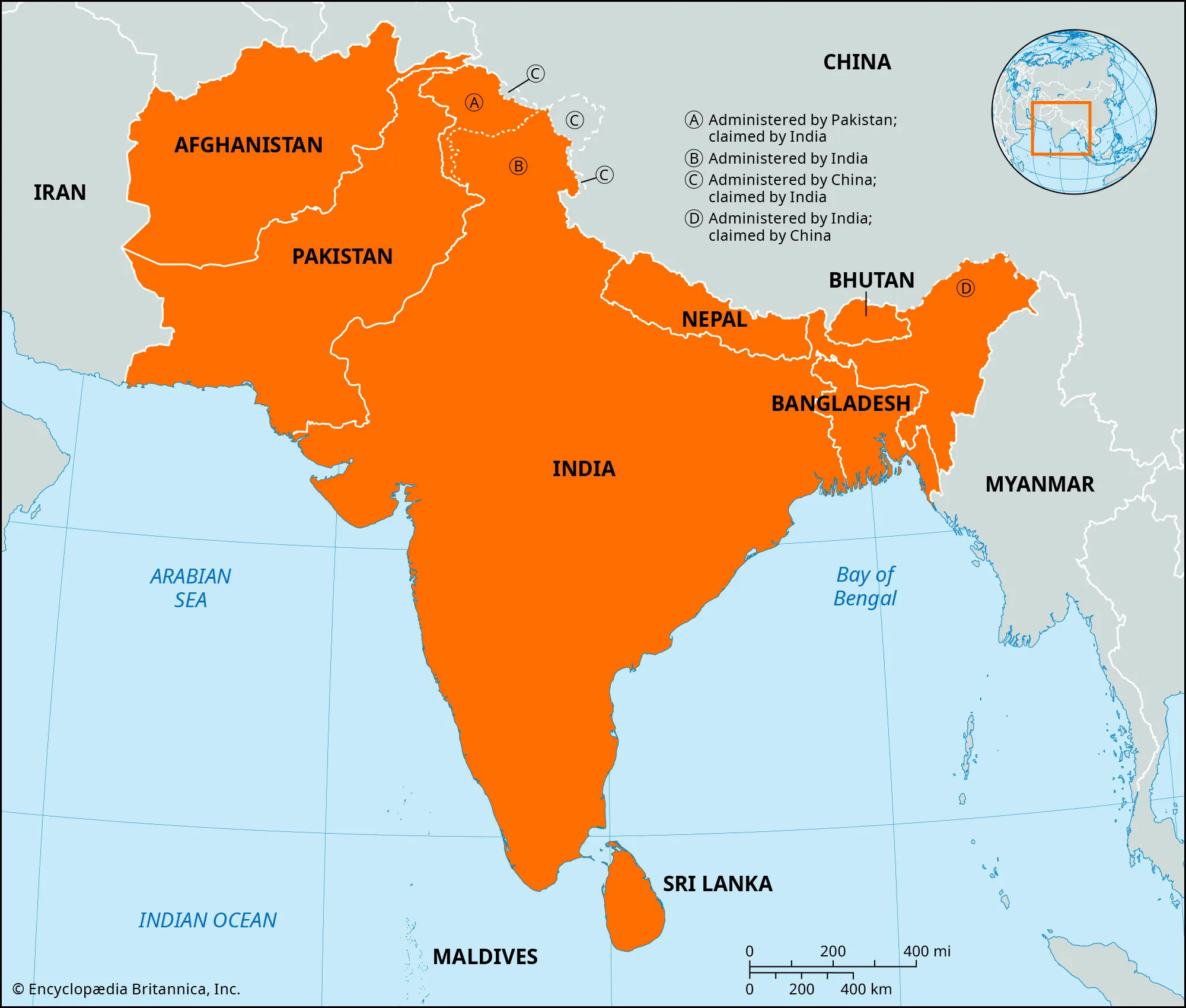Description
Daily Editorial Analysis
Editorial Analysis based on the article “The paradox of India’s global rise, its regional decline” published in The Hindu.
Introduction:
- One of the paradoxes of contemporary Indian foreign policy is that a globally India growing but regionally India is a declining power.
- India’s aggregate power has grown over the past two decades which is evident in robust economic growth, military capabilities, and a largely young demography.
Factors Leading to India’s Global Rise
- Multilateral alliances:
- Hosting of events such as the G-20 meetings, inclusion as an invitee at G-7 meetings, and active participation in multilateral groups such as the Quad, BRICS, and the Shanghai Cooperation Organisation further highlight its geopolitical significance and its powerful presence globally, even if it is not a member of the United Nations Security Council.
- Economic Boom:
- The World Bank has forecasted India's growth to reach 7.5% in FY24. Since the start of the 21st century, annual average GDP growth has been 6% to 7%.
- India's large and diverse market size is a magnet for foreign investors. With a population of over 1.3 billion people, India offers immense opportunities for businesses across various sectors. By 2030, India is projected to become the world's third-largest consumer market.
- Demographic Dividend:
- India's population is among the youngest in an ageing world. By 2022, the median age in India will be 28 years; in comparison, it will be 37 in China and the United States, 45 in Western Europe, and 49 in Japan.
- This demographic dividend provides a significant advantage in terms of a large workforce and potential for innovation and entrepreneurship. By harnessing its youthful population through skill development initiatives and education reforms, India can fuel economic growth and strengthen its position as a global powerhouse.
- Technology and Innovation Hub:
- India has emerged as a global hub for technology and innovation, particularly in the IT and software sectors. The country is home to a thriving startup ecosystem, with cities like Bangalore, Hyderabad, and Pune gaining recognition as tech hubs.
- Indian tech companies are making waves internationally, with firms like Tata Consultancy Services (TCS) and Infosys among the world's largest IT services providers. Additionally, India's space agency, ISRO, has achieved remarkable milestones, such as the Mars Orbiter Mission at a fraction of the cost compared to other space agencies.
- Power and Cultural Influence:
- India's rich cultural heritage, including its literature, music, cinema, and cuisine, contributes to its soft power and global influence. Bollywood, for instance, has a massive international following, and Indian cuisine is popular worldwide.
- The Indian diaspora, numbering over 30 million people, is spread across the globe and serves as a bridge between India and the rest of the world, fostering cultural exchange, trade, and investment.
- Rising Military Capabilities:
- India has been actively modernising its military capabilities through significant investments in defense spending. As of 2021, India's defense budget stood at approximately $73.65 billion, making it one of the top military spenders globally. INS Sahyadri, LCA Tejas and INS Vikrant are prime examples of India’s recently built military capabilities.
Factors are Leading to Regional Decline of India in South Asia:
- Strained Bilateral Relations:
- India's relations with certain neighboring countries, such as Pakistan and Nepal, have been marred by historical animosities, territorial disputes, and geopolitical rivalries. Persistent tensions and occasional conflicts have hindered efforts for regional cooperation and stability.
- China's Growing Influence:
- China's increasing economic, political, and military presence in South Asia has altered the regional dynamics, posing challenges to India's traditional dominance. Through initiatives like the Belt and Road Initiative (BRI), China has expanded its infrastructure projects and strategic partnerships in the region, sometimes at the expense of India's interests.
- Internal Instability and Conflict:
- Persistent internal conflicts and political instability within certain South Asian countries, such as Afghanistan, Bangladesh, and Sri Lanka, have limited their capacity for regional cooperation and engagement. India's efforts to promote stability and development in these countries have faced challenges amidst ongoing conflicts and power struggles.
- Low Regional Trade:
- Intra-regional trade in South Asia is already among the lowest in the world. India's trade with the South Asian countries has remained roughly between 1.7% and 3.8% of its global trade.
- Economic Disparities and Development Gaps:
- Despite India's economic growth and development, disparities within South Asia persist, contributing to regional tensions and mistrust. Economic disparities between India and its neighbors, coupled with unequal access to resources and opportunities, have fueled grievances and affected efforts for inclusive regional development.
- Security Challenges and Terrorism:
- Persistent security challenges, including cross-border terrorism and insurgencies, have undermined regional stability and cooperation. India's concerns about terrorism emanating from certain neighboring countries, particularly Pakistan, have strained bilateral relations and hindered efforts to build trust and cooperation in the region.
- Geopolitical Competition:
- Geopolitical competition among major powers, including India, China, and the United States, has influenced regional dynamics and exacerbated tensions in South Asia. Rivalry for strategic influence and access to resources has sometimes undermined prospects for cooperative regional initiatives.
- Limited Regional Integration Efforts:
- Despite various attempts to promote regional integration, initiatives such as the South Asian Association for Regional Cooperation (SAARC) have faced challenges in achieving meaningful cooperation and integration among member states. Differences in priorities, competing interests, and bilateral tensions have affected progress towards greater regional cohesion.
India’s challenges with neighbouring countries:
- China: The unresolved border dispute, particularly concerning the Line of Actual Control (LAC), has led to military standoffs, notably the recent Galwan Valley Standoff. India protests against China's String of Pearls Strategy and the China-Pakistan Economic Corridor. Recent territorial claims by China, encompassing Arunachal Pradesh and the Aksai Chin region, have raised tensions.
- Maldives: Recent political developments have witnessed anti-India sentiments under the "India Out" campaign had casted Indian presence as a sovereignty threat. Diplomatic disputes and China's expanding influence, raises concerns regarding India-Maldives relations.
- Bangladesh: India and Bangladesh's relationship is threatened with limited progress in water sharing agreements. India and Bangladesh have signed only 2 treaties out of 54 common rivers they share, including the Ganga Waters Treaty and The Kushiyara River Treaty. Illegal immigrants from Bangladesh including Rohingyas affect the India Bangladesh relations.
- Sri Lanka: Challenges persist in India's relationship with Sri Lanka, including disputes over the ownership of Katchatheevu Island, border security concerns, and tensions about China's increasing influence, particularly through infrastructure projects like the Hambantota Port.
- Nepal: The India-Nepal border dispute revolves around the Kalapani region and the Lipulekh Pass. The border dispute over Kalapani is rooted in competing interpretations of maps and ground evidence. Nepal claims that the river to the west of Kalapani should be the border, while India maintains control over the region based on its assertion of the eastern river as the border.
Way ahead:
- Diplomatic Engagement and Conflict Resolution:
- India should prioritise diplomatic engagement with neighbouring countries to address bilateral disputes and build trust. Initiating dialogues and confidence-building measures can help in resolving long standing issues such as border disputes, water-sharing agreements, and territorial claims.
- Economic Integration and Development Cooperation:
- India can promote economic integration and development cooperation initiatives to foster inclusive growth and address socio-economic disparities in the region. Enhancing trade relations, investing in infrastructure projects, and facilitating people-to-people exchanges can strengthen regional connectivity and prosperity.
- Security Cooperation and Counterterrorism Efforts:
- Strengthening security cooperation and counterterrorism efforts with neighboring countries is crucial for maintaining regional stability and addressing common security threats. Collaborative efforts in intelligence-sharing, border security, and counterterrorism operations can enhance mutual trust.
- Promotion of Soft Power and Cultural Diplomacy:
- Leveraging India's rich cultural heritage and soft power assets can enhance its influence in the region. Promoting cultural exchanges, educational scholarships, and tourism initiatives can promote greater understanding and goodwill among South Asian nations, consolidating India's cultural leadership.
- Regional Integration Mechanisms and Institutional Cooperation:
- India should actively engage in regional integration mechanisms such as the South Asian Association for Regional Cooperation (SAARC) while exploring alternative platforms for cooperation. Initiating joint projects, sharing best practices, and collaborating in areas like healthcare, climate change, and disaster management can strengthen regional solidarity and cooperation.
- Infrastructure Connectivity and Connectivity Projects:
- Investing in infrastructure connectivity projects, such as road, rail, and energy corridors, can enhance physical connectivity and facilitate economic integration within South Asia.
- Initiatives like the International North-South Transport Corridor and the Bay of Bengal Initiative for Multi-Sectoral Technical and Economic Cooperation (BIMSTEC) can serve as platforms for regional connectivity and cooperation.
- Balancing Major Power Dynamics:
- India should navigate the complex dynamics of major power competition in the region, particularly between China and the United States. By maintaining strategic autonomy and pursuing a balanced approach, India can safeguard its interests.
|
South Asia
It is the southern subregion of Asia, which is defined in both geographical and ethnic-cultural terms. As commonly conceptualised, the modern states of South Asia include Afghanistan, Bangladesh, Bhutan, India, Maldives, Nepal, Pakistan, and Sri Lanka.

|







